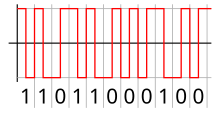Our website is made possible by displaying online advertisements to our visitors.
Please consider supporting us by disabling your ad blocker.
Line code






| Passband modulation |
|---|
 |
| Analog modulation |
| Digital modulation |
| Hierarchical modulation |
| Spread spectrum |
| See also |
In telecommunications, a line code is a pattern of voltage, current, or photons used to represent digital data transmitted down a communication channel or written to a storage medium. This repertoire of signals is usually called a constrained code in data storage systems.[1] Some signals are more prone to error than others as the physics of the communication channel or storage medium constrains the repertoire of signals that can be used reliably.[2]
Common line encodings are unipolar, polar, bipolar, and Manchester code.
- ^ K. Schouhamer Immink (2022). "Innovation in Constrained Codes". IEEE Communications Magazine. Retrieved 2022-10-05.
- ^ K. Schouhamer Immink (2001). "A Survey of Codes for Optical Disk Recording". IEEE Journal on Selected Areas in Communications. 19: 751–764. Retrieved 2018-02-05.
Previous Page Next Page


